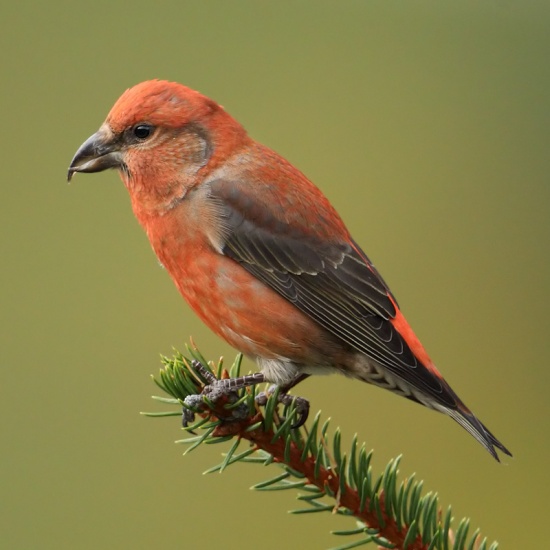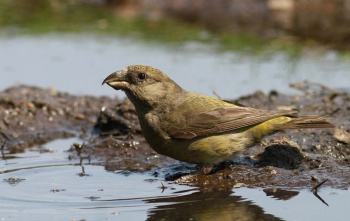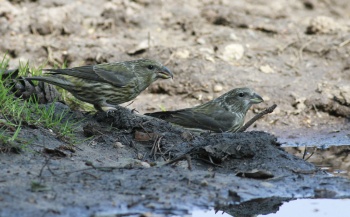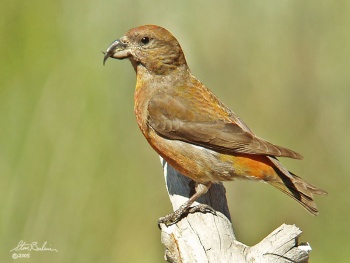Nutcracker (talk | contribs) (more details) |
Nutcracker (talk | contribs) (more details) |
||
| Line 1: | Line 1: | ||
| − | [[Image: | + | [[Image:Loxia curvirostra curvirostra by Momo.jpg|thumb|550px|right|''L. c. curvirostra'', male<br>Photo by {{user|Momo|Momo}}.<br>Ayer, Valais, [[Switzerland]]; October 2010]] |
;[[:Category:Loxia|Loxia]] curvirostra | ;[[:Category:Loxia|Loxia]] curvirostra | ||
Alternate name: Common Crossbill | Alternate name: Common Crossbill | ||
| Line 12: | Line 12: | ||
*Notched tail | *Notched tail | ||
'''Female''' | '''Female''' | ||
| − | [[Image:Common_Crossbill_female_by_Mahsleb.jpg|thumb|350px|right| | + | [[Image:Common_Crossbill_female_by_Mahsleb.jpg|thumb|350px|right|''L. c. curvirostra'', female<br>Photo by {{user|Mahsleb|Mahsleb}}.<br />Upper Hollesley Common, Suffolk, [[UK]], May 2012]] |
*Yellow-orange crown and rump | *Yellow-orange crown and rump | ||
*Olive-green body | *Olive-green body | ||
*Grey-brown wings and tail | *Grey-brown wings and tail | ||
| − | '''Juvenile''' | + | '''Juvenile''' |
| − | Streaked greyer-brown overall | + | *Streaked greyer-brown overall |
| − | [[Image:Common_Crossbill_juvies_by_Mahsleb.jpg|thumb|350px|right| | + | [[Image:Common_Crossbill_juvies_by_Mahsleb.jpg|thumb|350px|right|''L. c. curvirostra'', juveniles<br>Photo by {{user|Mahsleb|Mahsleb}}.<br />Upper Hollesley Common, Suffolk, [[UK]], May 2012]] |
| + | ====Similar species==== | ||
| + | [[Parrot Crossbill]], and particularly [[Scottish Crossbill]], are very similar; q.v. | ||
==Distribution== | ==Distribution== | ||
| Line 28: | Line 30: | ||
==Taxonomy== | ==Taxonomy== | ||
| − | Twenty-one subspecies are recognised<sup>[[#References|[ | + | [[Image:Red_Crossbill.jpg|thumb|350px|right|Male, probably subspecies ''L. c. bendirei''<br>Photo by {{user|forcreeks|forcreeks}}.<br>Cabin Lake, central [[Oregon]], USA.]] |
| − | *''L. c. curvirostra'' | + | Crossbill taxonomy is complex, and the validity of several of the taxa is disputed; several additional un-named taxa (particularly within ''L. c. curvirostra'', where seven different call type groups have been noted in western Europe alone<sup>[[#References|[1]]]</sup>) have also been suggested on the basis of differing call types. [[Scottish Crossbill]] probably also belongs as a subspecies here, though currently usually treated as a distinct species. At the other extreme, it has been suggested that all of the taxa could be considered as separate species. Most of the taxa have strong associations with feeding on particular conifer species; the quip has been made - not without good justification - that "For North American crossbill ID, perhaps the best field guide is ''The Sibley Guide to Trees''"<sup>[[#References|[2]]]</sup>. However, all will readily shift to other conifer species in the event of a crop failure in their preferred species, though their feeding efficiency will be lower when doing so (which may prevent successful breeding while 'surviving' on the 'wrong' conifer). ''L. c. sinesciuris'' was originally described as a separate species<sup>[[#References|[3]]]</sup> but was not accepted as such by the AOU. |
| − | *''L. c. corsicana'' | + | |
| − | *''L. c. balearica'' | + | ====Subspecies==== |
| − | *''L. c. poliogyna'' | + | Twenty-one subspecies are recognised<sup>[[#References|[4]]]</sup>; preferred food species noted where known: |
| − | *''L. c. guillemardi'' | + | ;Old World |
| − | *''L. c. mariae'' | + | *''L. c. curvirostra'' - most of Europe and northern Asia; on ''Picea abies, Picea obovata'' and other ''Picea'' species |
| − | *''L. c. altaiensis'' | + | *''L. c. corsicana'' - Corsica; on ''Pinus nigra'' |
| − | *''L. c. tianschanica'' | + | *''L. c. balearica'' - Balearic Islands; on ''Pinus halepensis'' |
| − | *''L. c. himalayensis'' | + | *''L. c. poliogyna'' - northwest Africa; on ''Pinus halepensis'' |
| − | *''L. c. meridionalis'' | + | *''L. c. guillemardi'' - Turkey, Cyprus, Caucasus; on ''Pinus brutia'' |
| − | *''L. c. japonica'' | + | *''L. c. mariae'' - Crimea; on ''Pinus nigra'' |
| − | *''L. c. luzoniensis'' | + | *''L. c. altaiensis'' - Altai and Sayan Mountains of central Asia; on ''Picea schrenkiana'' |
| − | *''L. c. | + | *''L. c. tianschanica'' - Tien Shan Mountains of central Asia; on ''Picea schrenkiana'' |
| − | *''L. c. sitkensis'' | + | *''L. c. himalayensis'' - Himalaya; on ''Tsuga dumosa'' and ''Picea'' spp. |
| − | *''L. c. | + | *''L. c. meridionalis'' - southern Vietnam; on ''Pinus kesiya'' |
| − | *''L. c. | + | *''L. c. japonica'' - Japan; on ''Picea'' spp. |
| − | *''L. c. grinnelli'' | + | *''L. c. luzoniensis'' - Luzon, Philippines; on ''Pinus kesiya'' |
| − | *''L. c. stricklandi'' | + | ;New World |
| − | *''L. c. mesamericana'' | + | *''L. c. minor'' - SE Canada, NE USA; on ''Tsuga canadensis'' |
| − | *''L. c. pusilla'' | + | *''L. c. sitkensis'' - coastal S Alaska, SW Canada, NW USA; on ''Tsuga heterophylla'' |
| − | *''L. c. sinesciuris'' | + | *''L. c. bendirei'' (syn. ''L. c. neogaea'') - SW Canada, NW USA; on ''Pseudotsuga menziesii'' |
| + | *''L. c. benti'' - central Rocky Mountains, USA; on ''Pinus'' spp. | ||
| + | *''L. c. grinnelli'' - SW USA (California, Nevada); on ''Pinus'' spp. | ||
| + | *''L. c. stricklandi'' - SW USA (Arizona, New Mexico), Mexico; on ''Pinus'' spp. | ||
| + | *''L. c. mesamericana'' - Central America (Guatemala, Nicaragua, Belize); on ''Pinus'' spp. | ||
| + | *''L. c. pusilla'' - Newfoundland; on ''Picea mariana'' | ||
| + | *''L. c. sinesciuris'' - northern Rocky Mountains, USA (local, on isolated South Hills range in Idaho); on ''Pinus contorta'' | ||
==Habitat== | ==Habitat== | ||
| − | Coniferous forests, with a preference for spruce ''Picea'' in most areas, but pine ''Pinus'' in the case of | + | Coniferous forests, with a preference for spruce ''Picea'' in most areas, but pine ''Pinus'' in the case of several subspecies, particularly those to the south of the species' main range where spruces do not occur. |
==Behaviour== | ==Behaviour== | ||
===Diet=== | ===Diet=== | ||
| − | They eat insects and the buds and seeds of many shrubs and trees | + | They primarily eat the seeds of conifers, extracted from the cones by twisting their bill tips between the scales; cones in the range 3-14 cm long are preferred. Other less important foods include insects and the buds and seeds of many shrubs and trees. |
====Vocalisation==== | ====Vocalisation==== | ||
<flashmp3>Loxia curvirostra (song).mp3</flashmp3><br /> | <flashmp3>Loxia curvirostra (song).mp3</flashmp3><br /> | ||
''[[Media:Loxia curvirostra (song).mp3|Listen in an external program]]'' | ''[[Media:Loxia curvirostra (song).mp3|Listen in an external program]]'' | ||
==References== | ==References== | ||
| + | #Robb, M. (2000). Introduction to vocalizations of crossbills in north-western Europe. ''Dutch Birding'' [http://www.dutchbirding.nl/content/journal/pdf/2000-2.pdf 22: 61-107]. | ||
| + | #[http://www.birdforum.net/showpost.php?p=1737232&postcount=14 Post #14] in the Birdforum [http://www.birdforum.net/showthread.php?t=159111 Crossbill taxonomy] discussion thread | ||
| + | #Benkman et al. (2009). A new species of the Red Crossbill (Fringillidae: Loxia) from Idaho. ''Condor'' [http://web.archive.org/web/20121002064620/http://www.uwyo.edu/benkman/pdfs%20of%20papers/benkman_et_al_2009.pdf 111 (1): 169–17]. | ||
#{{Ref-Clements6thAug11}} | #{{Ref-Clements6thAug11}} | ||
{{ref}} | {{ref}} | ||
Revision as of 00:28, 5 December 2014
- Loxia curvirostra
Alternate name: Common Crossbill
Identification
Length 14-20 cm, weight 23-53 g
Male
- Medium-sized finch
- Red-orange body
- Brighter red on rump
- Dark brown wings
- Dark bill with crossed tip
- Notched tail
Female
- Yellow-orange crown and rump
- Olive-green body
- Grey-brown wings and tail
Juvenile
- Streaked greyer-brown overall
Similar species
Parrot Crossbill, and particularly Scottish Crossbill, are very similar; q.v.
Distribution
Throughout most of the Northern Hemisphere, almost wherever substantial conifer forests occur.
In the Old World, more-or-less continuous from Scotland east to the Pacific coast of Russia, with more isolated populations south to northwest Africa, the Mediterranean islands, Turkey, the Himalaya, southern Vietnam, and Taiwan.
In North America, from southern Alaska, Manitoba, Quebec, and Newfoundland, south in the west to northern Nicaragua, and in eastern United States to Wisconsin and North Carolina (in mountains). This bird winters irregularly south to the Gulf coast.
Taxonomy
Crossbill taxonomy is complex, and the validity of several of the taxa is disputed; several additional un-named taxa (particularly within L. c. curvirostra, where seven different call type groups have been noted in western Europe alone[1]) have also been suggested on the basis of differing call types. Scottish Crossbill probably also belongs as a subspecies here, though currently usually treated as a distinct species. At the other extreme, it has been suggested that all of the taxa could be considered as separate species. Most of the taxa have strong associations with feeding on particular conifer species; the quip has been made - not without good justification - that "For North American crossbill ID, perhaps the best field guide is The Sibley Guide to Trees"[2]. However, all will readily shift to other conifer species in the event of a crop failure in their preferred species, though their feeding efficiency will be lower when doing so (which may prevent successful breeding while 'surviving' on the 'wrong' conifer). L. c. sinesciuris was originally described as a separate species[3] but was not accepted as such by the AOU.
Subspecies
Twenty-one subspecies are recognised[4]; preferred food species noted where known:
- Old World
- L. c. curvirostra - most of Europe and northern Asia; on Picea abies, Picea obovata and other Picea species
- L. c. corsicana - Corsica; on Pinus nigra
- L. c. balearica - Balearic Islands; on Pinus halepensis
- L. c. poliogyna - northwest Africa; on Pinus halepensis
- L. c. guillemardi - Turkey, Cyprus, Caucasus; on Pinus brutia
- L. c. mariae - Crimea; on Pinus nigra
- L. c. altaiensis - Altai and Sayan Mountains of central Asia; on Picea schrenkiana
- L. c. tianschanica - Tien Shan Mountains of central Asia; on Picea schrenkiana
- L. c. himalayensis - Himalaya; on Tsuga dumosa and Picea spp.
- L. c. meridionalis - southern Vietnam; on Pinus kesiya
- L. c. japonica - Japan; on Picea spp.
- L. c. luzoniensis - Luzon, Philippines; on Pinus kesiya
- New World
- L. c. minor - SE Canada, NE USA; on Tsuga canadensis
- L. c. sitkensis - coastal S Alaska, SW Canada, NW USA; on Tsuga heterophylla
- L. c. bendirei (syn. L. c. neogaea) - SW Canada, NW USA; on Pseudotsuga menziesii
- L. c. benti - central Rocky Mountains, USA; on Pinus spp.
- L. c. grinnelli - SW USA (California, Nevada); on Pinus spp.
- L. c. stricklandi - SW USA (Arizona, New Mexico), Mexico; on Pinus spp.
- L. c. mesamericana - Central America (Guatemala, Nicaragua, Belize); on Pinus spp.
- L. c. pusilla - Newfoundland; on Picea mariana
- L. c. sinesciuris - northern Rocky Mountains, USA (local, on isolated South Hills range in Idaho); on Pinus contorta
Habitat
Coniferous forests, with a preference for spruce Picea in most areas, but pine Pinus in the case of several subspecies, particularly those to the south of the species' main range where spruces do not occur.
Behaviour
Diet
They primarily eat the seeds of conifers, extracted from the cones by twisting their bill tips between the scales; cones in the range 3-14 cm long are preferred. Other less important foods include insects and the buds and seeds of many shrubs and trees.
Vocalisation
<flashmp3>Loxia curvirostra (song).mp3</flashmp3>
Listen in an external program
References
- Robb, M. (2000). Introduction to vocalizations of crossbills in north-western Europe. Dutch Birding 22: 61-107.
- Post #14 in the Birdforum Crossbill taxonomy discussion thread
- Benkman et al. (2009). A new species of the Red Crossbill (Fringillidae: Loxia) from Idaho. Condor 111 (1): 169–17.
- Clements, JF. 2011. The Clements Checklist of Birds of the World. 6th ed., with updates to August 2011. Ithaca: Cornell Univ. Press. ISBN 978-0801445019. Spreadsheet available at http://www.birds.cornell.edu/clementschecklist/downloadable-clements-checklist
Recommended Citation
- BirdForum Opus contributors. (2024) Red Crossbill. In: BirdForum, the forum for wild birds and birding. Retrieved 18 April 2024 from https://www.birdforum.net/opus/Red_Crossbill







